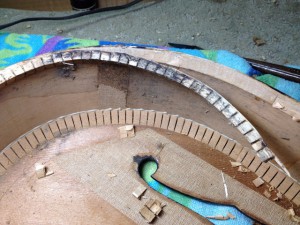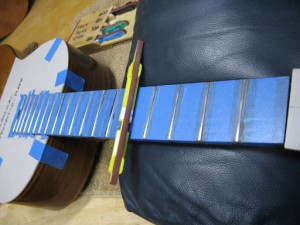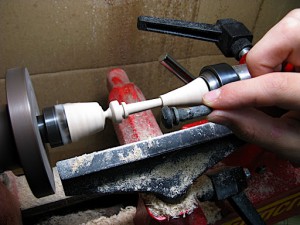Executing Craft
Restorations

Lining with extensive mold damage being removed and replaced.
Originality and value require a special focus with restorations. Structure and playability are important but heavily counterbalanced against originality and value – I strive to leave the instrument as close to its original condition as possible, taking great care to leave its patina intact.
Restoration is a labor of love, often time consuming where every detail matters. Often times the instruments that come to us are of sentimental value, maybe bought original by one’s father or in the family since new. We document restorations so that the owners may see the work in progress and witness the rejuvenation of their guitar.
Periodically we see instruments that require very specialized knowledge for restoration – this may be due to antiquity, the nature of restoration work (e.g. special finishes) or simply we believe a better qualified luthier exists to place in care of the instrument. In this case we will work with the client to refer the guitar out to a specialist.
Repairs
Most repairs are the result of a mishap, defective workmanship, or just wear and tear. I look to return structural soundness to an instrument, minimizing any aesthetic or sonoral impact to the instrument. This can include structural issues – separated braces, cracks and holes in the body, broken necks and headstocks, bridge damage or separation. We can perform neck resets, fret level and crowns, and refreting as needed.
Finish repairs are also performed for all types of finishes, including lacquer, urethane and french polish. Some finishes can be oxidized or full of minor scratches, which we can fill, buff and bring back to like new condition.
From time to time I also receive instruments which have had previously unsuccessful or unsatisfactory repairs. Whether from another luthier that may have not been qualified to perform the repair or from an owner’s attempt to fix the instrument, I am often asked to resolve such issues.
Setups & Upgrades

Fret level on a Smallman braced Spanish classical guitar.
One of the most effective ways to improve a guitar’s playability is by having a setup performed by a qualified luthier. Unlike the wood craft of guitar construction or repair, setups require very precise changes to the nut, saddle frets and neck angle. Small changes (even those amount to several thousandths of an inch) can make a profound improvement to ease of play.
I seek to understand the client’s playing style and establish the best possible setup which improves playability and minimizes hand fatigue. Based on the client’s playing style and environment in which the instrument is used, I will make specific changes to optimize the guitar to the player’s maximum benefit. Upon receiving their newly setup guitar, clients often exclaim their instrument feels completely different and plays with amazing ease.
Factory guitars especially benefit from a setup as they often set with high actions. A setup is one of the most effective and inexpensive ways to significantly improve one’s instrument.

